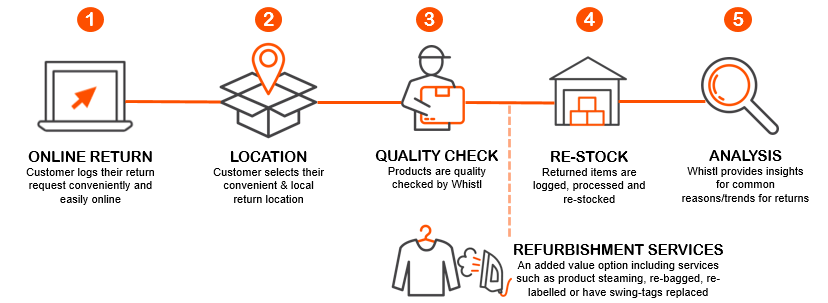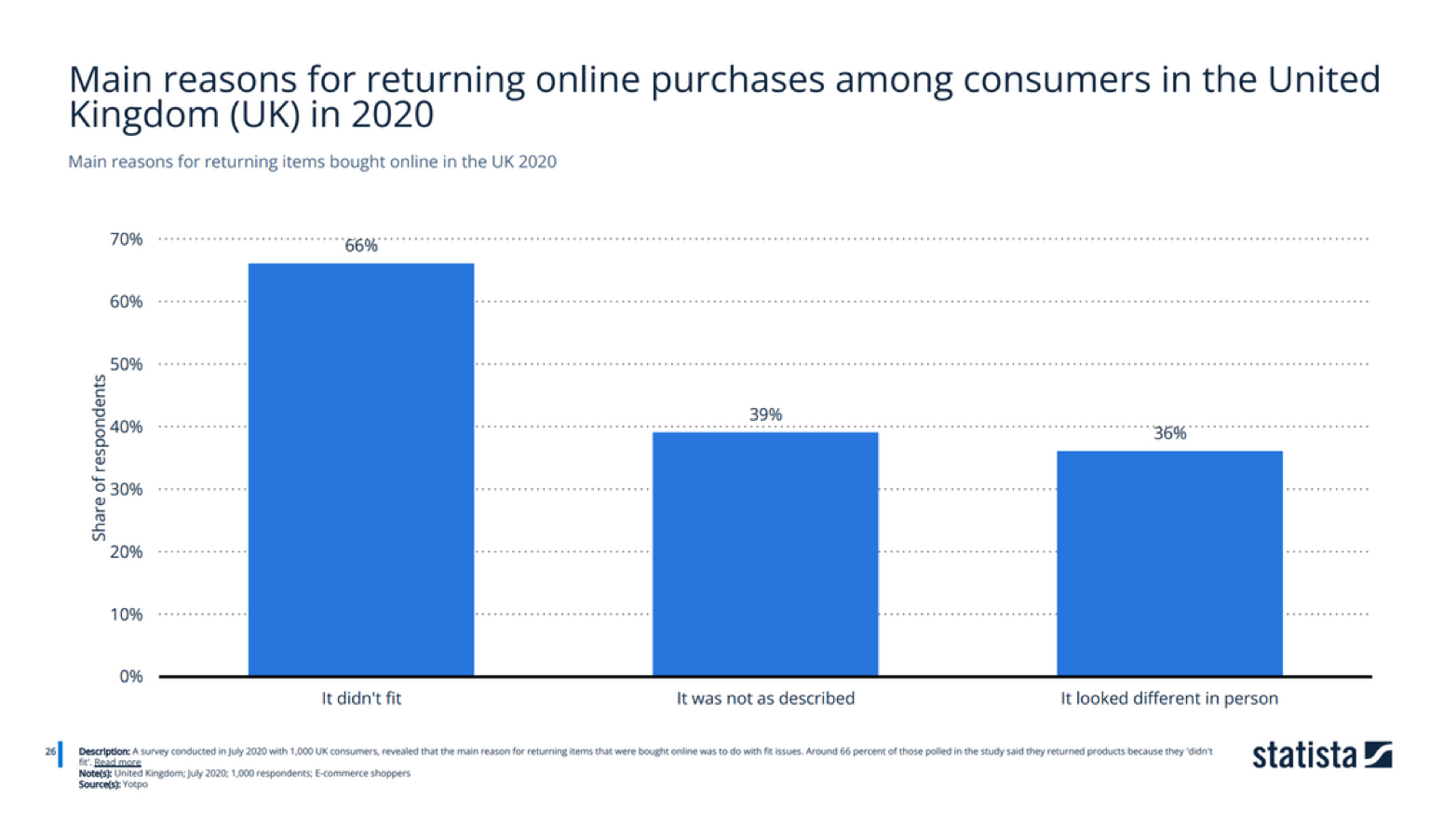In this article we cover how an effective eCommerce returns strategy can help you deliver a best-in-class customer experience. But first of all, what is returns management?
Returns management is best defined as the retail logistics operations process that is catalysed by a customer deciding that they no longer want or need a product and wish to send it back. This can either be in exchange for a full refund, a like-for-like product, a variation of the same product, or in an emerging trend, ‘no-return returns’ (as detailed in this video ‘Master Reverse Logistics. Get Ecommerce Returns Right’) - scenarios in which it is uneconomical for a customer to ship an item back to the retailer and the retailer simply gives their customer a full refund, letting them do as they please with their item, be it damaged, unsuitable or no-longer required.
How does the returns management process work?
Once a consumer has decided they no longer want or need a product, or simply that it isn’t what they ordered, their parcel return begins with a customer contacting the retailer’s eCommerce customer service team, or logging into the online store to complete a return request. Following this, the customer will choose a convenient local return location. At this point a parcel returns service can be booked and shipped back to either the retailer, or outsourced fulfilment centre. Once the parcel, packet or mail item arrives back at the warehouse a quality check is performed by the pick and pack team. Depending on the returned item’s condition it will either be restocked, refurbished or in the case of ‘reverse logistics’, recycled. At the Whistl Group we go one step further and provide analysis of our delivery returns service to give the retailer insights into the reasons for their returns.

Which are the main reasons why consumers decide to return a product?
A study by Statista called ‘Online deliveries and returns in the United Kingdom (UK)’ found that the majority, 66% of consumers returned items because they did not fit. Furthermore, 39% of the 1,000 consumers interviewed had returned because items were ‘not as described’. 36% of the respondents had returned their online purchases because the item looked different in person.

Another reason for returns is the ‘serial returner’, customers who retailers discover are either over-ordering, over-returning or in some instances, wearing the products before returning them. Back in 2019, major retailer ASOS decided to adjust its return policy to clamp down on serial returners. At Whistl we wanted to know what the public thought about the changes proposed by ASOS and whether they would affect sentiment towards the retailer. 76% of respondents to the survey supported this policy. Overall only 8% of consumers disagreed with the changes which increased to 16% when specifically related to ASOS shoppers.
A final factor determining eCommerce return rates is, most surprisingly, fraud; Research from the National Retail Federation found that of the estimated $0.4 trillion in merchandise returned to US retailers in 2020, 5.9% were fraudulent.
What is the current state of eCommerce returns?
Last year 8.1% of eCommerce purchases were returned, so this can make or break your business’s profitability. Research from TheCircularBoard found as many as 54% of Britain’s online shoppers regularly return their purchases. The same study found 32% sometimes return their items. This implies that around 9 out of 10 shoppers will deal with a seller’s return policy at some point, including the additional unmeasured proportion who rarely return their items.
As a result, by not making returns as frictionless as possible, this can impact your eCommerce user experience, conversion rates and customer lifetime value.
What is the difference between returns management and reverse logistics?
Returns management involves the collection of a product from the consumer, delivery to the retailer or fulfilment centre, and restocking.
Reverse logistics, on the other hand, is a broader term that can include services such as recycling programs, product disposal and in the instance of wholesalers who may sell on credit terms, asset recovery. Connected deeper into a retailer’s supply chain, reverse logistics monitors variables such as the proportion of returned items that can be re-manufactured.
As with eCommerce returns, reverse logistics requires accurate inventory management to orchestrate returned items, their stock levels and the condition of returned products. While eCommerce returns typically prioritises a frictionless customer experience, rapid stock replenishment and profit, reverse logistics can be more easily optimised towards reducing a business’s carbon footprint.
Some examples of reverse logistics in action are:
- Refurbishing damaged items so they can be resold (or sending them back to the original equipment manufacturer (OEM) to do the same)
- Recycling products to create alternative products
- Collecting and reworking unsold products from brick-and-mortar stores
- Returning packaging materials and pallets to the manufacturer for reuse in inbound logistics - Thanks to rising demand for sustainable packaging and government regulations encouraging eco-friendly packaging innovations, the Returnable Packaging market is predicted to be worth $170.44bn by 2030.
The value of an effective returns policy
A study by Narvar, a post-purchase customer experience platform, found 96% of online shoppers would return an item to a business that offered a frictionless, hassle-free returns policy, and 62% would buy again from retailers who offer free returns.
Actionable tips to help you minimise returns and make it a competitive advantage
To ensure you are achieving eCommerce returns best practice, it would be prudent for online merchants to:
- Create a clear multi-channel returns policy that keeps your customers coming back for more, but prevents certain segments from abusing the system; namely:
- Profile your customers to identify the serial returners and optimise your returns policy with returns limits.
- Ensure your contact centre team is trained to perform returns as per customers’ requests via live chat, email or telephone. Your returns policy should be crystal clear, ensuring call centre staff never have to make decisions, just implement the correct protocol.
- Give your website and marketplace visitors more accurate sizing recommendations to minimise the incidence of sizing-related returns; consider introducing AI-powered body-measuring technology to capture customers’ body measurements and translate them into highly accurate size recommendations, minimising the chance of ‘wrong-size returns’.
- Deploy a multi-carrier delivery strategy that includes carrier partners who have a core competency in returns delivery and tracking.
Whistl helps online retailers enhance their returns offering
At Whistl we offer a dedicated, expert team of product returns experts, ensuring returned products are processed efficiently to support your re-stocking, resale and reverse logistics requirements.
Get in touch with our team today so we can help deliver a better returns customer experience.
Join our mailing list
Sign up and receive all the latest industry news and insights directly to your inbox.
Research, Insights and Industry Guides
In depth insights and research studies to help you better understand customer perceptions & expectations.
Share this article

Contact us to find out more!
We'll help you find the right courier management software solutions for your business needs.
Call us
We'll call you
Complete our contact form


